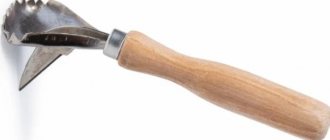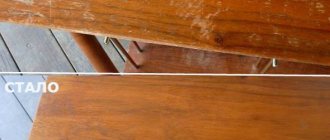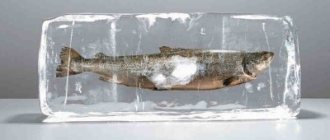Many fish lovers complain that they have to refuse to buy a fresh carcass because it is not easy to clean. Scattered and poorly separated scales cause a lot of inconvenience and heavily pollute kitchen surfaces. A special knife for cleaning fish will help you cope with the problem; it will make it easier to remove scales, and will also partially prevent them from spreading around the room. This piece of kitchen utensil is an excellent opportunity not only at home, but also on the go, to quickly and effortlessly clean your catch of all unnecessary things.
Distinctive features
There are many models of knives for removing scales, most of them have one thing in common - the cutting profile is not smooth, it has teeth and notches on one of the edges or spine, which make it easier to remove scales. Other distinctive characteristics of such a device:
- The hardness of steel is from 55 to 60 HRC, since a soft blade will complicate the cleaning process.
- Medium blade length - a large knife will only bring inconvenience and the risk of injury.
- A narrow and flexible blade makes it easier to manipulate with such a product.
- Stainless steel - otherwise the blade will rust from working in a damp environment.
- The handle is medium size, the covering material is wood, plastic or rubber. Metal handles are not recommended as they slip.
An ideal option for the kitchen would be a Japanese-made product. The Land of the Rising Sun has long been famous for its knives and blades, their hardness is at least 60 HRC.
Types of knives for removing scales from fish
There are many offers on the market for purchasing a fish cleaning knife. The choice depends solely on the wishes of the person, his requirements, and budget. Do not confuse a cleaning knife with fish cutting products.
With a fake edge
A product with a false sharpening is a knife with a standard blade, on the back of which there is an additional cutting edge. It is not suitable for slicing, but does a good job of cleaning fish carcasses. The disadvantages of the knife include the risk of injury from the second blade.
This model is universal, since with the right choice, the second edge can be used for planing fish. The false blade does not need editing; its function is only to peel off the scales.
With serrated sharpening
A knife with a serrated blade has a wavy or sawtooth edge, the teeth are located in the same plane. There are many subtypes and forms of such sharpening, but any of them makes it easier to remove scales due to these same teeth.
Products with a serrated cutter have a longer cut due to the fact that the edge runs along a curved line. It is easier to operate with such a knife and requires less effort due to the fact that it cuts at different angles. Sharpening on such models lasts longer: even if the blade is partially dull, it still retains its cutting properties.
If we talk about the disadvantages, we can highlight two points: the teeth tend to become clogged with scales and pieces of meat, and a completely dull blade is difficult to sharpen for a non-professional; it will require some skill and several different whetstones.
With long flexible blade
This model is a classic product among fish cleaning knives. It is characterized by a budget price and can easily get rid of small scales. This knife is versatile and can be used for other purposes. The only negative is that during operation you can only rely on the strength of your hands, since this model does not have any additional advantages.
Professionals do not recommend purchasing a tool with a blade that is too long and thin; it will spring back when force is applied.
Fish scalers with teeth and notches
This invention appeared on the market back in Soviet times and has since been actively used in the kitchen. In appearance and design it resembles a small grater with a handle. There are models with one slot or several. The choice rather depends on the cooking habit. The teeth along the edges provide additional contact with the scales, pry them off, and also slightly keep them from spreading throughout the kitchen.
Such knives for cleaning fish from scales themselves are inexpensive, but it is still recommended to refrain from purchasing cheap Chinese alloys; the product may simply bend during use. The tool is quite easy to use and the processing speed is above average. But this model is traumatic: if the blade slips, the cook risks seriously scratching his hand.
With container for collecting scales
The undoubted advantage of this option and the reason for its popularity is the presence of a container for collecting scales. It is enough to move the knife back and forth over the carcass, and all the garbage will collect itself in the container; the cook will only have to empty it from time to time. In terms of its design, this product differs little from a fish scaler with teeth and notches; the principle of a grater also applies here.
Its price is low, operation is simple, and the cook does not need to collect scales throughout the kitchen after the procedure. Among the disadvantages: such models have a plastic body, including the container, so they are short-lived.
Electric fish scaler
This kitchen gadget for cleaning fish scales will come in handy for those who process a large number of fish carcasses. With manual tools, your hand will get tired, no matter how convenient the knife is. The electric device should simply be moved along the scales. It is recommended to choose models with a container to avoid unnecessary cleaning.
There are products that operate on mains power or battery power. The latter device is convenient because you can take it with you on a fishing trip to prepare fish soup from a freshly caught catch. Modern devices have a waterproof casing and are easy to disassemble and clean. Processing with their help will be fast, easy, and safe. The only drawback of an electric gadget is its cost, which is 2-3 times higher than a manual fish scaler.
Rules for choosing a device
If everything is clear with special devices, they are distinguished by price and functionality, then simply choosing a knife for cleaning scales is more difficult. Most housewives try to clean fish with the same tool that they use for other operations in the kitchen. This is wrong - a knife for these purposes should always be individual, which is necessary for hygienic reasons, because the fishy smell will eventually become embedded in any product. It is for this reason that it is not recommended to use knives with a wooden handle; it is better if this part is made of plastic or rubber. If the choice falls on wood, it must have a varnish coating to prevent the spread of bacteria.
Among other recommendations for choosing a knife for cleaning fish from scales:
- The shape of the handle is welcome: it is simple, fits comfortably in the palm, is of medium width and weight - the hand will quickly get tired of the massive device.
- It is preferable to choose a product from high-carbon stainless steel; such material will protect the cutting edge from early rust and corrosion.
- The blade should be of moderate flexibility. The extremely flexible product is easy to break, and the rigid ones are difficult to manipulate.
Knives that are too wide or long are inconvenient when peeling scales. Among the tools for cleaning fish, there are products with smooth blades; knives with a serrated blade are also in demand. In practice, it has been proven that models with teeth are still more convenient and easier to get rid of scales. A fillet knife with a smooth and thin blade will be an ideal option for separating meat from bones and skins, and shredding planed meat.
The handle should be comfortable
Blade flexibility should be moderate
Choose stainless steel knives
Is it possible to clean fish with a regular knife?
If you don’t have a special tool at hand, cleaning can be done with a regular knife. The procedure will be somewhat more complicated, but still doable. This can be done in two ways: by placing the tip forward towards the skin or by turning the butt of the knife towards the carcass. The first method is most often used, but the second is safer, and there is also less chance of cutting up the fish. Actions step by step:
- Before starting the process, it is recommended to cut off the fins; this is easiest to do with ordinary kitchen scissors.
- The fish carcass is placed on the board with its tail facing the cook, after which it is placed in a container of water, due to which the scales scatter less.
- The fish is cleaned from the tail to the head.
- The cleaned carcass is washed under running water.
You can also do the entire procedure described above by placing the fish in a plastic bag, but this method greatly restricts movement, although it guarantees cleanliness in the kitchen.
Cut off the fins
Rinse and steam
You need to brush from tail to head
Rinse under running water
Tips for cleaning fish
Firstly, it should be remembered that freshly caught fish is always much easier to clean than fish that has been stored for some time.
- As a rule, the best option is to clean the caught fish directly near the reservoir.
- To cut fish, it is better to use only sharp and high-quality knives.
- Cleaning of fish is carried out exclusively on a special cutting board for fish.
- The cleaning process must be careful and of high quality. The quality of the cooked fish will depend on this.
- Before starting such a process, it is advisable to place the fish in cold water with vinegar.
- It will be much easier to clean the fish if you insert a wooden stick into its mouth all the way or fix its tail on the board itself. Holding the fish by the eyes with your fingers, pull it out until a characteristic crunch appears.
- To hold the fish firmly with your fingers, you can wrap the tail of the fish with a napkin or rub your fingers with salt if there are no abrasions on them.
Secrets to quickly removing scales
In addition to standard cleaning methods and the use of modern devices, experienced housewives have special secrets for removing scales. Popular tricks that will simplify and speed up the procedure:
- It is easier to clean the carcass if it is fixed. There is no need to hold it with your hand; it is easier to do this with a board with a special clamp. If it is not there, you can secure the fish by pinning it by the tail with a fork to an ordinary wooden plank.
- To prevent the carcass from slipping in your hands, it is recommended to lightly sprinkle it with salt.
- It is difficult to remove the scales from some breeds of aquatic inhabitants; in large individuals, for example, large perches, they are like armor. To soften the cover, you need to scald it with boiling water or cover the fish with coarse salt overnight.
Don’t forget to keep the carcass in water before cleaning, as dried scales are more difficult to remove.
If the fish does not clean well, place it in salt overnight
Best way to capture fish
To prevent your hands from slipping, you can sprinkle the fish with salt.
Prices for fish scalers
The average price for these devices is about 4 thousand rubles.
The advantages of fish scalers include:
- Speed and quality of cleaning.
- Easy to use.
- Mechanical fish scalers are much cheaper than electric ones.
- When using electric fish scalers, the cleaning process is much faster, although there is a possibility of damage to the fish flesh.
- The scales do not scatter in all directions, unlike conventional cleaning methods.
How to clean fish without special equipment
People with imagination come up with a lot of ways to clean fish without a cleaning knife. To do this, sometimes unexpected materials are used:
- Beer caps. To construct a fish scaler, several lids are attached to any board or handle with the teeth facing up.
- A piece of a tin grater, or, as an option, make several holes on a metal sheet.
- A regular steel wool can also help remove fish scales easily.
- A spoon or fork that is used with the end on. Surprisingly, the handle of the cutlery can easily deal with small scales.
- A standard vegetable peeler will also cope with fish, but in the future you should not use it on fruits.
Fish with small scales can be cleaned by rubbing them well with coarse salt. There are many options for getting rid of scales: from the most modern to folk ones. So don’t give up your favorite dish just because fish is difficult to clean.
You can create a device from beer caps
A vegetable peeler is suitable for fish.
You can use a tin grater
DIY fish cleaning device
Mechanical devices, in the form of various graters, are sold both in stores and on the market. Despite this, such devices are easy to make at home, showing skill and dexterity. It is enough to take a wooden block and a piece of tin with holes around which there are sharp notches. If you attach the tin to a block, the resulting device will help you quickly clean the fish.
How and with what to quickly remove scales from perch and other fish - a simple DIY cleaning
It is not difficult to make a grater from an ordinary tin can if you drill several holes of the required diameter in it.
A grater can also be made from beer bottle caps. To do this, you also need to take a piece of wooden block and stuff several caps onto it, with the notches facing up. The result is a simple, and at the same time, effective device for cleaning fish.
If it is difficult to make a grater due to the lack of necessary parts, then you can use a fork or spoon. At the same time, the scales will scatter in all directions. To prevent this from happening, it is better to place the fish in a plastic bag.











